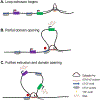Chromatin insulator mechanisms ensure accurate gene expression by controlling overall 3D genome organization
- PMID: 38810546
- PMCID: PMC11317221
- DOI: 10.1016/j.gde.2024.102208
Chromatin insulator mechanisms ensure accurate gene expression by controlling overall 3D genome organization
Abstract
Chromatin insulators are DNA-protein complexes that promote specificity of enhancer-promoter interactions and maintain distinct transcriptional states through control of 3D genome organization. In this review, we highlight recent work visualizing how mammalian CCCTC-binding factor acts as a boundary to dynamic DNA loop extrusion mediated by cohesin. We also discuss new studies in both mammals and Drosophila that elucidate biological redundancy of chromatin insulator function and interplay with transcription with respect to topologically associating domain formation. Finally, we present novel concepts in spatiotemporal regulation of chromatin insulator function during differentiation and development and possible consequences of disrupted insulator activity on cellular proliferation.
Published by Elsevier Ltd.
Conflict of interest statement
Declaration of Competing Interest The authors declare that they have no known competing financial interests or personal relationships that could have appeared to influence the work reported in this paper.
Figures




Similar articles
-
High-resolution CTCF footprinting reveals impact of chromatin state on cohesin extrusion.Nat Commun. 2025 May 15;16(1):4506. doi: 10.1038/s41467-025-57775-w. Nat Commun. 2025. PMID: 40374602 Free PMC article.
-
Function and regulation of chromatin insulators in dynamic genome organization.Curr Opin Cell Biol. 2019 Jun;58:61-68. doi: 10.1016/j.ceb.2019.02.001. Epub 2019 Mar 12. Curr Opin Cell Biol. 2019. PMID: 30875678 Free PMC article. Review.
-
Pushing the TAD boundary: Decoding insulator codes of clustered CTCF sites in 3D genomes.Bioessays. 2024 Oct;46(10):e2400121. doi: 10.1002/bies.202400121. Epub 2024 Aug 21. Bioessays. 2024. PMID: 39169755 Review.
-
Dynamic barriers modulate cohesin positioning and genome folding at fixed occupancy.Genome Res. 2025 Aug 1;35(8):1745-1757. doi: 10.1101/gr.280108.124. Genome Res. 2025. PMID: 40628528 Free PMC article.
-
Permeable TAD boundaries and their impact on genome-associated functions.Bioessays. 2024 Oct;46(10):e2400137. doi: 10.1002/bies.202400137. Epub 2024 Aug 2. Bioessays. 2024. PMID: 39093600
Cited by
-
22q11.21 Deletions: A Review on the Interval Mediated by Low-Copy Repeats C and D.Genes (Basel). 2025 Jan 9;16(1):72. doi: 10.3390/genes16010072. Genes (Basel). 2025. PMID: 39858619 Free PMC article. Review.
References
-
- de Wit E, Nora EP: New insights into genome folding by loop extrusion from inducible degron technologies. Nat Rev Genet 2023, 24:73–85. - PubMed
-
- Davidson IF, Barth R, Zaczek M, van der Torre J, Tang W, Nagasaka K, Janissen R, Kerssemakers J, Wutz G, Dekker C, et al. : CTCF is a DNA-tension-dependent barrier to cohesin-mediated loop extrusion. Nat 2023 6167958 2023, 616:822–827. - PMC - PubMed
-
This work used a single-molecule assay involving tethered DNA under lower flow conditions to show that cohesin mediated loop extrusion is occluded preferentially by the N-terminus of CTCF in a tension-dependent manner. DNA tension, generated by loop extrusion, allows CTCF to regulate cohesin through multiple mechanisms – direction switching of cohesin mediated extrusion, blocking loop extrusion, and loop shrinkage.
-
- Zhang H, Shi, Banigan EJ, Kim Y, Yu H, Bai X chen, Finkelstein IJ: CTCF and R-loops are boundaries of cohesin-mediated DNA looping. Mol Cell 2023, 83:2856–2871.e8. - PubMed
-
This work used a single-molecule assay involving tethered DNA under higher flow conditions. The authors observed that the N-terminus of CTCF blocks cohesin while the C-terminus accelerates cohesin translocation. Furthermore, certain ribonucleoproteins and R-loops can also act as barriers to cohesin translocation. They utilize Cryo-EM to visualize the zinc fingers of CTCF bound to DNA plus the YDF N-terminal motif interacting with the STAG1 subunit of cohesin.
-
- Karpinska MA, Oudelaar AM: The role of loop extrusion in enhancer-mediated gene activation. Curr Opin Genet Dev 2023, 79:102022. - PubMed
Publication types
MeSH terms
Substances
Grants and funding
LinkOut - more resources
Full Text Sources
Molecular Biology Databases

